Summer 2006 SST Unit in Senegal
Mon, 10 Apr 2006We are here
I think we are over the time change, but the barking
dogs at night still make sleep a little sporadic. We
have begun meeting families for student placement
and next week start a road trip to meet service
families and check out assignments. Our country
rep, Alain, is very prepared and is doing a great job
for GC.
Our living situation is good, and will get better
when we actually move into the rooms planned for
us on the second floor. We are waiting for the
carpenter to finish the completely hand made solid
wood doors and window sills. It will be nice to get
out of suitcases.
After many trips to the phone/internet company, I
think our connection is set to be put in this week.
That will be nice!
Here are a few photos of our life. Once people are a
bit more used to the toubabs (whites in Wolof) that
live in their neighborhood I won’t feel quite so
touristy with the camera.
Photos left to right:
Teresa with grand daughter,
Amaelle
Laura and Amaelle, the sweetest two-year-olds you
can imagine, grand daughters of our “host mom”
Teresa,
Lime pie the neighbor made on a little BBQ grill.
Entry to courtyard
Dining room
Suella and Amaelle and Laura
Gwen eating the baguettes available every 50 yards
and a staple of the Senegalese diet.
That’s if for now.
Please feel to write:
suellag@goshen.edu
gwenjm@goshen.edu



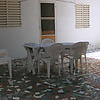
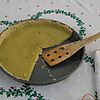


Sun, 23 Apr 2006
Sunday, April 23, 2006
It has been a full week for us. Wednesday morning
we left for a two-day road trip to visit the homes
and assignments where students will be for their
service. The trip included a stop in Thies, where
two students will live and work, and an overnight in
St. Louis where another two students will be. We
returned late Thursday and left even earlier on
Friday morning for the Petite Cote. The four
neighboring villages there will host the remaining
10 students. Some of the most moving moments
for us were sitting in a living room and having the
woman of the home tell us that they are praying for
the students that are coming. Having Muslim
communities praying for American Christians is
something that needs to be known. We were
assured over and over that the entire village would
relate with the students as one of them, that they
are welcome and will be cared for.
Returning home on Saturday afternoon we moved in
our new rooms at home. And we do consider
ourselves at home. Last Sunday we attended Easter
Mass with our family then joined the family for a
holiday fete. Mass was particularly memorable: the
cross, commissioned by the late Pope John Paul,
arrived in Dakar on Good Friday, and we were
fortunate to have it in our parish on Easter Sunday.
Senegal is the first African country to host the
cross, which has been traveling around the world.
The next few days will be filled with finishing the
syllabus, finalizing the schedule, making final
contacts, and finally, going to the airport to greet
the long-awaited students from Goshen. Senegal,
known for its teranga (hospitality) is
waiting!
Captions:
Alain Badaine our coordinator extraordinare
Scenes from along the route to visiting service
assignments
Alain and Gwen eating cashew fruit, better than the
nut in my opinion
The gorgeous beach at St. Louis





Sat, 29 Apr 2006
Arrival and families
During the stay at L’Epicea, they were eager
students of Wolof, with enthusiastic teachers at
every turn! It is one thing to learn and speak
French in Senegal, but learning Wolof is the real
indication of one’s intention to learn about Senegal;
efforts to speak Wolof are warmly rewarded. The
orientation ended with the students making
chep
bu jen, the national dish, with their Wolof and
French teachers (Moutarou in the white and Mama
Bineta in the red). The dish is rice, fish, and
vegetables with a variety of seasonings and is eaten
around a bowl. Traditionally it is eaten with the
hands, which we did as well…that is, everyone but
Alain! The student and staff interactions were
wonderful to watch. Ndaye, the woman responsible
for taking care of us, said they would miss them
and indicated how great they are. (Parents, you
have fine children.) After singing the doxology to
the staff, we said our good-byes and were on our
way to meet host families, at last!
The families came to pick up students at St.
Augustin, the center where language classes and
lectures will be held. We sat around the room and
one by one their families came. The students
served juice and pastries to their families before
going home with their new mother or sister or
brother. The willingness of students and families
to take on these new relationships is a huge
expression of love and generosity.










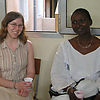


Thu, 4 May 2006
Classes, relaxing, singing
Tuesday morning we gathered for the first day of
Wolof. Our group of 15 students and two leaders is
divided into four classes for Wolof, giving us plenty
of opportunity to practice in the classroom setting.
After two hours, we had been introduced to over a
dozen greetings. In Senegal, greetings are
extremely important, and seldom—if ever—is one
greeting sufficient. Another interesting
characteristic of greetings is the number of ways
and times that “peace” is used. And there is a
similarity to Mennonites: the importance of last
names! When last names are exchanged, they are
repeated at least twice to each other before
continuing with the conversation. (And again, like
ethnic Mennonites, the pool of last names is
relatively limited.)
After a Senegalese lunch break, students returned
from home for a lecture on the history of Senegal.
Professor Thioub, in a two-hour-no-break lecture,
gave a dynamic history of the country, from pre-
colonialism to the present.
Wednesday morning was our first gathering as a
group chez Gwen et Suella. We began our morning
together with worship, learning several new French
songs, a time silence/reading/prayer, and then the
hymn singing. Their singing reputation preceded
them and we already have requests to hear them
sing! Of course, no gathering is complete without
hackey-sack, played anywhere, anytime!
AND the big news is! we finally, after another 2
trips to the internet company, 4 conversations and
a headache have internet at our house. So now we
will be able to post more regularily. Thanks for your
patience. I think I have the meaning of that word
down pat.






















Wed, 10 May 2006
Week two
During the next few weeks, we will share student writings of their experiences in Dakar.
First impressions from Nate
•Where is the grass?
•No weather forecast is necessary; it’s the same sun and ocean breeze each day.
•Cold showers are preferred, let alone the only option.
•French, although the official language, is second to Wolof.
•It’s silly to ask, “How are you?” to a friend eating a mango. Of course they’re feeling pretty awesome at the moment!
•Pants aren’t that much hotter than shorts.
•Saturday morning "Scooby-Doo" is better when dubbed into French.
Journal entry 4/27/06 from Alana (For their first week of journal entries, students were asked to record new sensory experiences.)
Dakar is chaos—-but what a beautiful one! Everything is concrete, sand, trash, cars zooming everywhere they can, Senegalese people milling everywhere, loud music, beautiful clothing, smiles, hot sun, and so much more! I just went outside the door of our hotel room onto our small patio on the second floor to hear the Muslim call to prayer. It’s so beautiful—-the sing-song prayer, the view—-even though images of the music video we saw earlier keep flashing through my head and my mind is a helpless jumble of English, French, and Wolof—-all of that doesn’t matter at night when the sky is so black that people melt right in, crickets are chirping, the goats next door are shuffling around sleepily, and the chaos has cooled with the temperature. In the mornings—-it’s loud, lots of construction, so much to remember; when school lets out—-it’s a river of children and people going everywhere; at suppertime—-there’s loud music and lots of conversation; and at night—-it’s peaceful. A noisy plane punctuates the stillness every now and then—-its roar so loud that it can cut off the most insistent, passionate Senegalese trying to explain the differences between English, French, and Wolof.


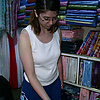











Tue, 16 May 2006
Time is flying
On Saturday morning we were given a tour of the
mosque, owned by the government because it
allows visitors. Unfortunately the large sanctuary
was closed for renovation, but we were allowed to
look into the small chapel where people gather to
pray five times a day. Only practising Muslims are
allowed into the chapel. Some of the practices were
explained including why one is required to wash
ones self three times for purification before each
prayer as well as how many prayers are to be
recited at various times of the day.
Sunday afternoon we took everyone to the beach
north of Dakar at Yoff. Business was slow so the
guys that were taking care of the beach rounded up
boards for everyone who wanted one. Tree ripened
mangos were available at a stand down the street
and fun was had by ALL.
Today we took the ferry to Goree Island, which was
one of the main harbours where ships docked to be
filled with slaves. It is a solemn place, especially
the slave house that would house 200 people in a
space smaller than most of our homes. The Door
of No Return, where slaves were ushered onto the
plank to walk to the waiting ships is especially
sobering.
The only form of economy on the island is tourism
so one’s visit is tainted with all the women vying for
attention to get you to visit their shops and buy the
trinkets. There is however a thriving artists colony
that has squatters rights in the bunker below the
enormous cannon at the top of the hill.
We had a great lunch of grilled fish or chicken,
most of the students chose chicken as fish has
been on the table almost everyday, vegetables and
rice. Lunch was so reasonably priced we splurged
and bought European ice cream bars for dessert,
the smiles were well worth the price.
Tomorrow is the day many of us have been waiting
for. We are going to a day-long batik workshop.
Alain Badiane, our Senegal coordinator, has been
whetting our enthusiasm as he frequently wears
batik shirts made by Mr. Ma, the instructor.
The group is having great conversations as well as
a lot of fun together and things are going to be way
too quiet in three weeks when they leave for their
service assignments.
Some intense thought goes into learning the
djembe next 8 pictures
3 pics of the beach at Yoff, where signs of pleasure
were heard as people began to relax.
2 pics of shopping for tissue at the Tilne
Market.
2 pics of the tour of the Grand Mosque. Then there
is the group pic infront of the Mosque a few
pictures later. I thought I could move them after
they were posted, but it turns our that I cannot.
The remaining pics are from the boat ride to Goree
and the time on the Island.
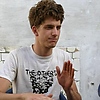
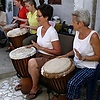




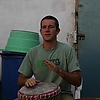





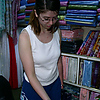

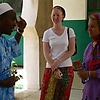
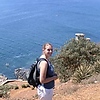




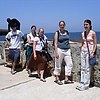





Wed, 17 May 2006
More Goree Photos
Can you pick out the GC students on the Goree
beach? :)
Sarah is at the "Door of No Return."
Nate and Suella are walking on the look out deck of
the prison which was closed in the '70's since there
was only one prisoner from the island. Senegal is a
country of very low crime.
The last photo is of the students against the wall
during the mini lecture at the slave house.




Fri, 19 May 2006
Batik and rugby
Also if you look close (the bleachers were a ways off
and night was falling) you will see Charles
Bontrager playing rugby in the African Cup!
We just finished a really busy week.
Monday we had French and then watched a movie
by a Senegalese film maker, Ousmene Sembene and
had a discussion afterwards with two literature
professors, Tuesday we went to Goree, Wedensday
we did
Batik all day, Thursday, French, group lunch
together,
worship time and then a lecture on HIV in Africa,
Friday, French and a lecture on political conflicts in
Africa and thoughts on ways of mediation and
resolution. The lecturer was a law professor at the
University of Dakar, who helped revise the Senegal
constitution. We were VERY fortunate to find him
available to speak to us.





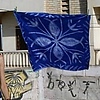
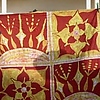





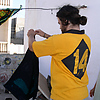
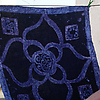
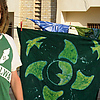



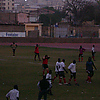



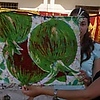
Tue, 23 May 2006
Rugby 2

Fri, 26 May 2006
Flexible
On Sunday we traveled by bus to Keur Moussa, a
Benedictine monastery outside of Dakar. For some,
it was a first Catholic mass; for others it was the
third Sunday in a row to attend mass. The worship,
the liturgy, and the serenity of the space provided a
welcome reprieve from the demanding life in the
city.
For the soccer fans among us, we had planned to
attend the match between Senegal and South Korea
on Tuesday. When we discovered a number of
weeks ago that the match was in South Korea, we
changed plans to watching it on television. But the
game started during French class, so that plan
altered as well! But given that we are now masters
in flexibility, we settled for dinner, with students
treating themselves to scoops of ice cream to top
off the evening.
Today, the typical G/S (Gwen and Suella) day took
place on Ngor Island. A pirogue ride took
us to the island in about five minutes, where we
spent the day sharing, worshiping, eating, playing,
and reading.
One of the pleasures of being with this group is
that they completely enjoy being with each other.
Time together is always filled with laughter, fun,
and play. The group members respect each other,
feel safe and cared for by each other, and are
generous with each other. The values of
teranga (hospitality) are evident within the
group.
Captions:
Chapel and interior at Keur Moussa, (2 pics)
Students standing around after mass
Students having a fun time rediscovering ice-cream


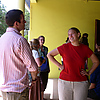




Sat, 27 May 2006
More pics from Isle de N'gor
Getting on the pirogue to N'gor
In the boat
Group time around the table before the noon
meal
Brad chatting with Alain
Snorkling after lunch settled (3 pics)







Thu, 8 Jun 2006
Routine and School for the Deaf
Alana had a particularly exciting day this week,
when after three trips to the Centre Verbo Tonal
she finally found the school for the deaf, right in
our neighborhood! Her face lit up as she
communicated with the students using ASL. It was
heartwarming to watch the exchange, the pleasure
of the communication between strangers.
Weekly G/S group time is another routine that has
become important in the group. With last minute
schedule changes, we met early in the week for fruit
salad and ice cream, as well as singing, sharing,
and group discussion.


Trip to St. Louis
After an early start for the trip we stopped in Thies,
a city about one hour east of Dakar. In Thies we
were welcomed by Annelise Goldschmidt, a French
missionary, who is GC’s local contact. After
pastries and coffee and juice, we listened to a
lecture on the history and development of
Christianity in Senegal, particularly Protestant
Christianity.
Upon our late-afternoon arrival in St. Louis, we
took a tour through the island, noting in particular
the architecture, driving through the Lebu village
(local fisherman), and other sites of interest. After
dinner we found our way to the annual Jazz Festival
before heading to bed, ending a long day.
Saturday morning began with another tour, this
time driving out of the city, visiting the University
of St. Louis and the dam that separates the Senegal
River from the ocean. The river divides Senegal and
Mauritania, so we left the country for a few minutes
to enjoy the ocean air and the open space. After a
free afternoon—of shopping and relaxing—we
dined at the Coup de Torchon before heading back
to the Jazz Festival.
On the return trip we stopped at Turtle Village, a
park that is home to over 100 turtles, from ones
that are several months old to one that is 125
years-old. The park prepares the turtles to live in
the wild; next month they will release 50 turtles.
After a final, brief stop at Lac Rose, we headed back
to Dakar, where students are now at home, where
they were welcomed back by their families, where
their community is familiar.
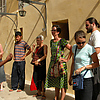


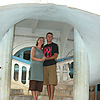





Fri, 9 Jun 2006
Christian Mission Work lecture in Thies


Turtle Village
The turtle in photo 3 has such large humps in its
shell because it is so overweight. Apparently when
turtles do not have a proper diet their shells collect
fat deposits. When the turtle was brought to the
village its shell was so heavy it could not walk. Now
it can move, but is extra slow.


Off to Service
Then we headed to St. Louis where Nate and Brad
will be working at a horticultural and animal
husbandry school.
Friday we got in a bus and headed south with the
10 students that will be working in the Saloum
Island villages.
Emily and Alana are working in Samba Dia at a
clinic that is run by Dr Gakou. Dr Gakou is the
contact for us in the area and found women in
various villages for hosting the students. He also
promised to check in on all of them in a week to
make sure they were healthy.
The next stop was at Djiofior, where Kate, Alex,
Sarah
and Elizabeth are working with a women's
cooperative. We are not sure what all they will be
doing, but the women assure us they will be busy. I
am anxious to visit to find out how it is going.
Another interesting part of their service is that the
people in these villages are Serer, which is a
matriarchial society. I am curious what
observations they will return with.
Then it was down a sandy, windy, road to Fimela,
where Eric B. and Kayla will be working at a
pharmacy, health clinic and with women's groups.
And last, but of course not least, we dropped off
Charles and Trevor in Djilor (not the one you see on
a map.This one is just 2 k from Fimela). They have
6 brothers! one
named Charles. They will be helping out at a
fishing compound, working in the fields and
probably teaching hacky sack to all the brothers.
The warmth with which each student was
received was overwhelming and
Suella, Alain and I were more than a little jealous
that we had to return to the hustle and bustle of
Dakar.





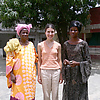


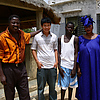



Mon, 12 Jun 2006
Last blog for awhile
Just want to let you all know as soon as I get the
picture of Eric Krabill and his service family that I
will not be posting anything else for 3 weeks.
Around that time we will do the midway visit to the
students and have stories and pictures to post.
Tue, 27 Jun 2006
Service Visits
On the way back to Dakar we stopped in Thies to
visit Eric. His assignment gets him in the classroom
and a metal workshop, where he helps his father
teach young people how to repair small equipment.
On the right are pictures of the workshop and
finally a picture of Eric with
his family.
Photos are gleaned from Nate, Brad and Eric:
Tiny little 1 inch blades of grass give a green haze
to the landscape.
Brad with brothers infront of bedroom door that is
used for a blackboard.
View from Brad's window
"Football" field where many late afternoons are
spent conditioning for the fall soccer season.
Garden
Brad and two students trying to sell the cauliflower
in the market. It is not a common vegetable here
so it can be a bit difficult to sell. The restarants are
happy for it though.
Base of banana tree that is waiting to be trimmed,
weeded and mulched.
Nate working for the camera.
Young banana trees.
Nate and father.
More lush gardens, I think okra is the big one in the
foreground.
Nate and little brother.
Nate's dad watching world cup. No one gets back to
work ontime after lunch this month since the
games are from 3-5 p.m. Lunch is "supposed" to
end ometime around 3:30 but football take
priority.
Nate's mother working in the courtyard.
Nate helping the mason prepare the cement for
retiling the bathroom.
Front of Nate's house.
Eric with family.
Bosch workshop where Eric spends his days.
Inside of workshop.
Eric's host father, Damien, at work.

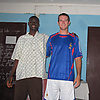


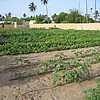








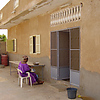







Mon, 3 Jul 2006
Sarah's pictures
During the first three weeks as a daughter in her family, she was invited to be an attendant for her neighbor's wedding.
The courtyard is the center for most activity. Under the mango tree, Sarah is getting her hair done. And looking up into the tree is fellow SSTer, Kate Harnish.
Sarah, Kate, Alex, and Elizabeth all live in the same village. Their sisters planned an outing; they spent the day relaxing and enjoying each others' company.
Finally, Sarah is getting her hands painted. Using henna, designs are painted onto hands, fingers, feet. Over time it will wear off, but until then, look at those lovely hands!









Alex's Pictures Merrrr! Alex, who coined the term, showing a "merrr!" face while prepping vegetables. Two of Alex's sisters pose for her camera. Assorted family members spend time shelling les arachides (peanuts) in the shade, while Alex works at her laundy. The last three pictures are from the day spent in Djilor when Gwen, Suella, Alain, and Leena went to visit the villages. Kayla, Alex, Trevor, Charles, Eric, and Emily are shown relaxing.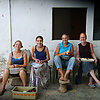









Tue, 4 Jul 2006
Visiting Students in Djilor, Diofior, Samba Dia and Femila
Pictures 1-3: The students came together from the different villages to spend the day with Gwen and Suella, accompanied by Alain, Leena, and Claude, our chauffer. After a lunch of chicken and frites we relaxed around the table.
Picture 4 is in Charles and Trevor's home. From left to right: father, Claude, their mother, and Alain.
Picture 5-6: Eric and Alana are chatting and catching up while Emily reads her mail from home.
Picture 7: Sarah, Kate, Leena, and Elizabeth are packed into the car, ready to head back to Diofior for the night.
Picture 8: Sarah, Elizabeth, Charles, and Trevor are reading their mail, sharing their news with each other.
Picture 9: Alain and Suella picking up Eric and Kayla in front of Kayla's house.
Picture 10: Leena relaxing in the hammock.



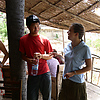





Sun, 16 Jul 2006
Back in Dakar We will
spend today and tomorrow as a group at a small
auberge (sort of like a B&B) and at the beach. So
check in on Tues for some pictures.
Just want to let everyone know the
students all arrived safely back in Dakar. The
groups seems pretty mellow after 6 weeks of life at
a much slower pace and the noise ande hustle of
Dakar now seems like culture shock.
Tue, 18 Jul 2006
Project presentation
Eric created a manual, complete with detailed illustrations, for small engine repair.
Nariel created a book about the baobab tree, including recipes for using flowers and leaves, as well as folklore and legends.
Alana, an ALS major, spent time at the deaf school in Dakar, talking with students and teachers, and observing and learning sign language in French.
Kayla worked with the NGO, World Vision, which provides nutritional education and tracking of children in the villages.
Kate, to better prepare future students for SST in Senegal, wrote an interactive short story, providing multiple choices for next chapters and endings.
Trevor made a language guide for Senegal visitors, collecting words and phrases in French, Wolof, and Serer. (Trevor won the award for learning the most Serer while on service.)
Sarah created an illustrated guide for dying fabric, creating patterns, as they learned the process in Djiffior.
Alex wrote poetry, capturing the images and relationships from Djiffior. (Keep your eyes open for her poetry in print.)
Emily, working alongside her family making meals, collected and wrote recipes. How will chep bu dien taste made in Goshen?)
Elizabeth watched the birds of Senegal during these three months. She created an illustrated guide of birds, and also a number of Djiffior sky charts with constellations identified.
Nate spent time in a clinic in St. Louis, observing and learning about some medical services that are offered.
Eric, to be prepared for playing soccer, observed, collected, and used a variety of body building exercises, all exercises that use the body itself for resistance weight.
Charles wrote a tongue-in-cheek guide for dating.
Brad worked at the artisan village, with an artist, making a wooden chair to take home.














![]()
International Education Office
Kevin Koch
kevinak@goshen.edu
+1 (574) 535-7346